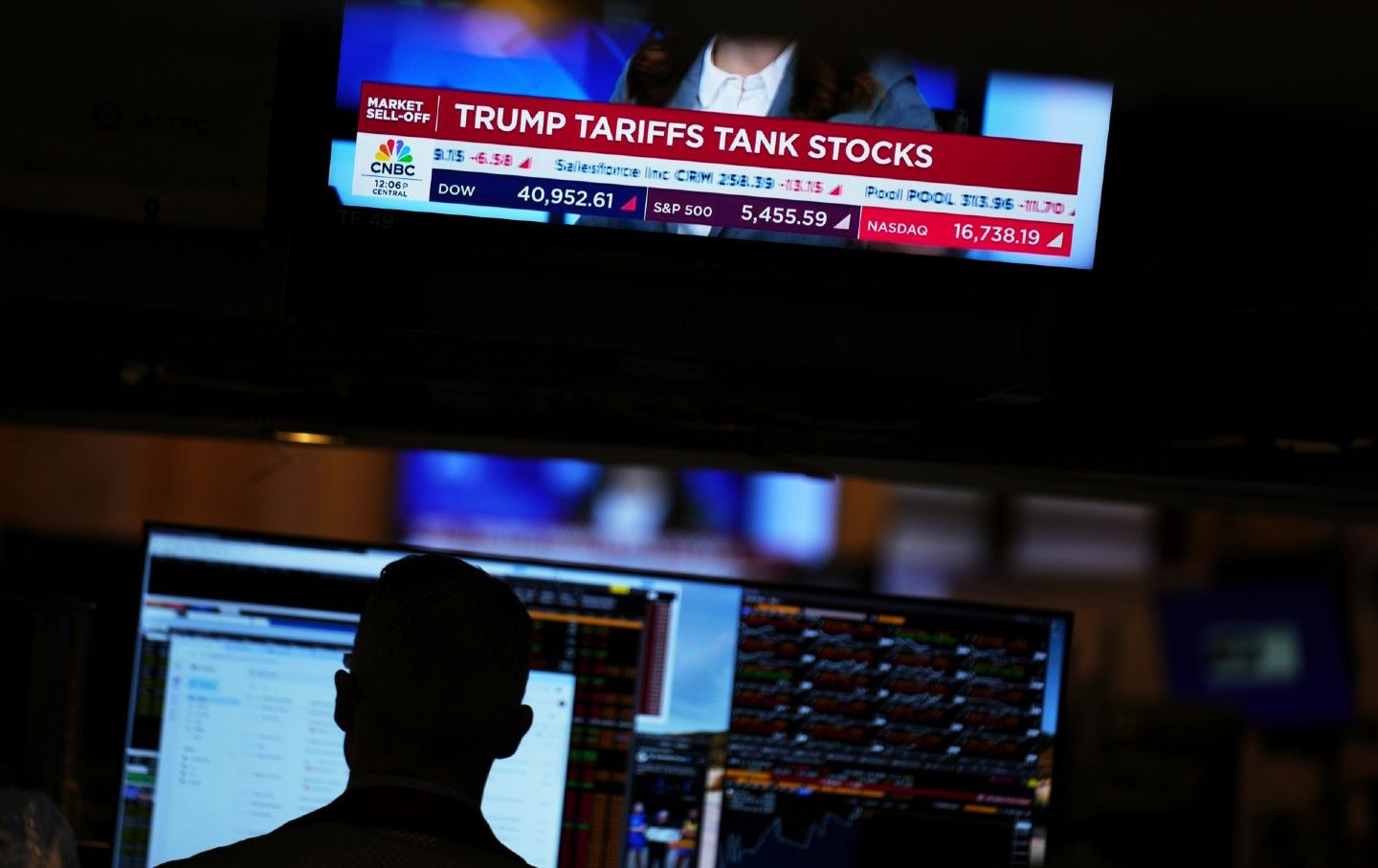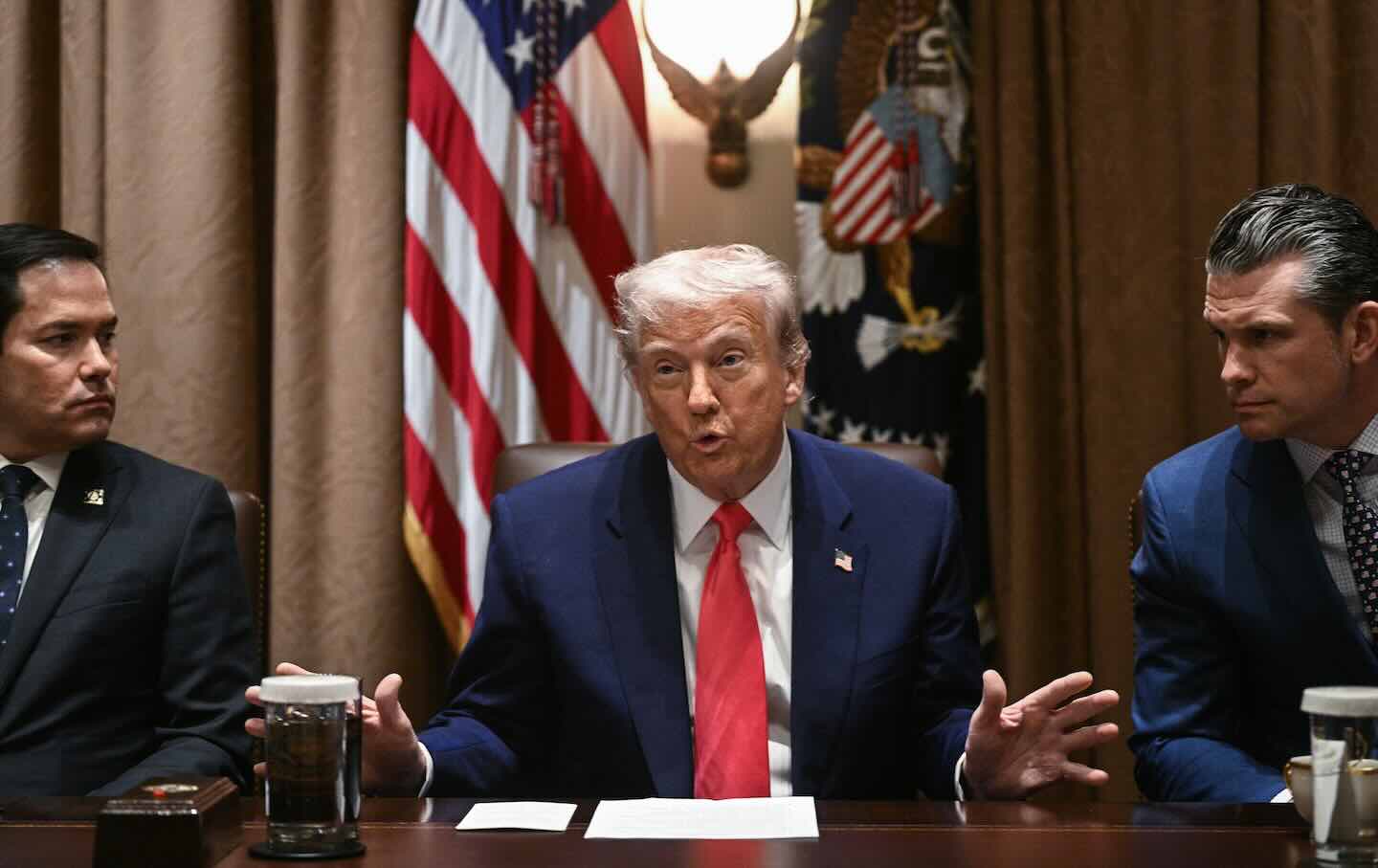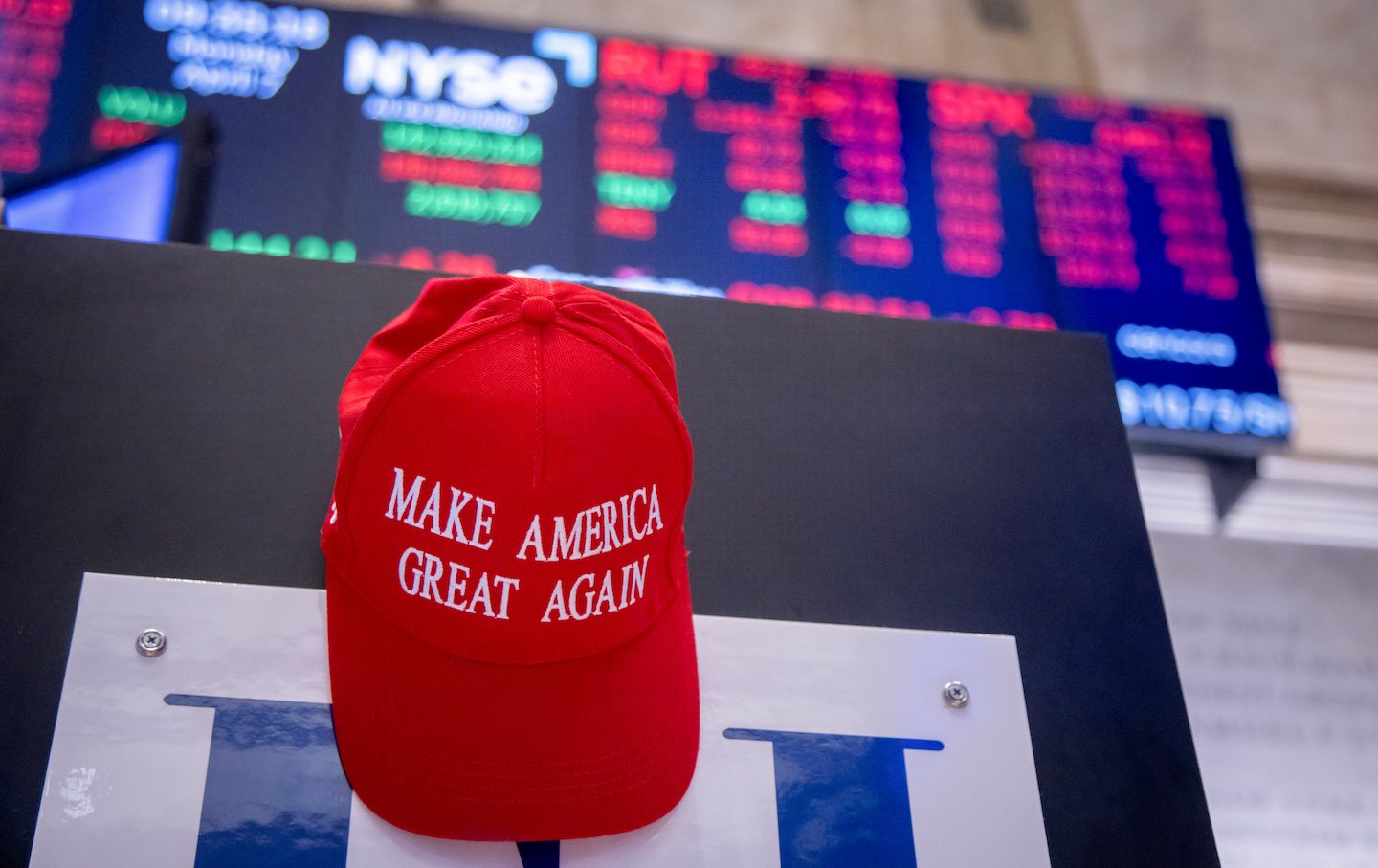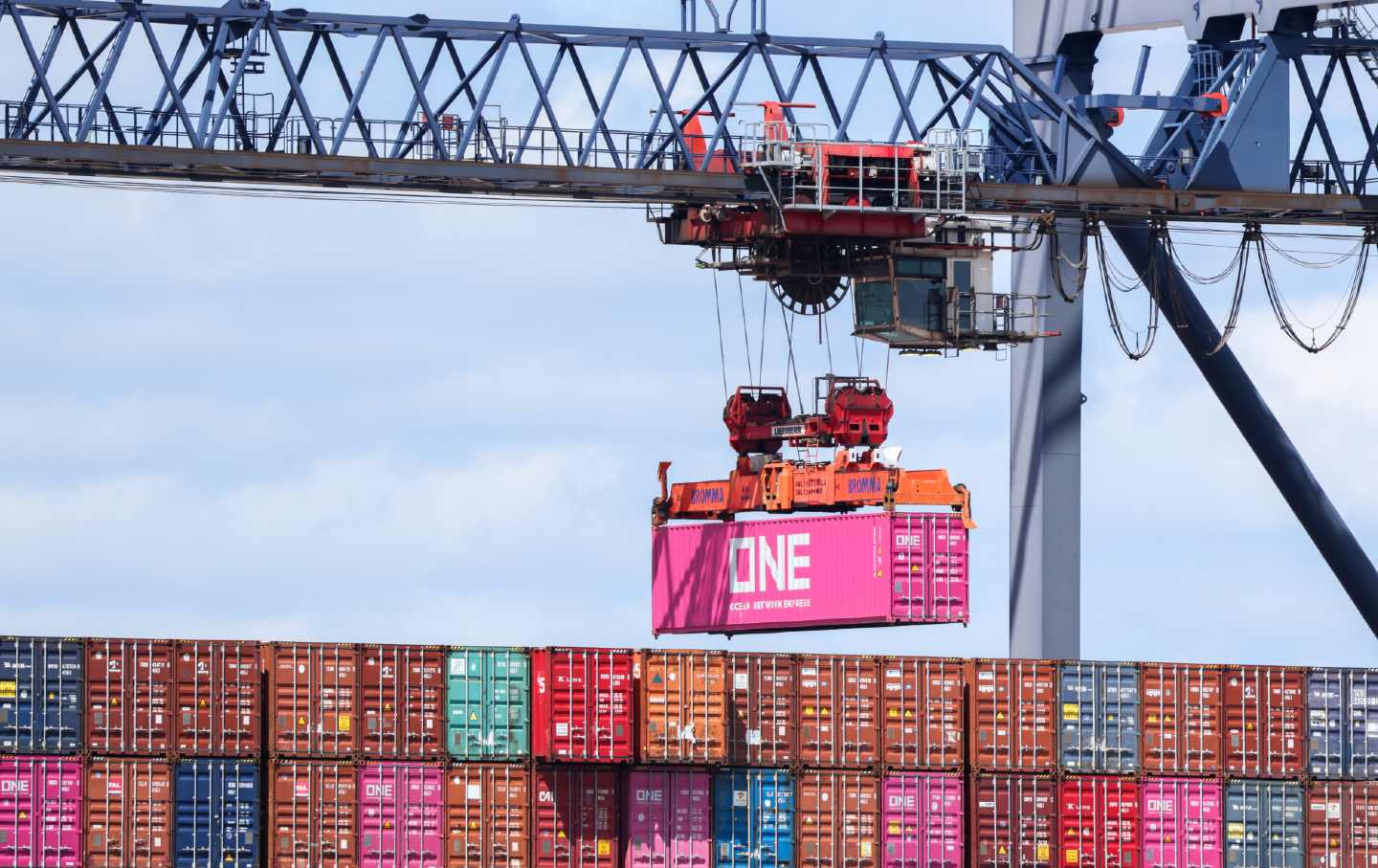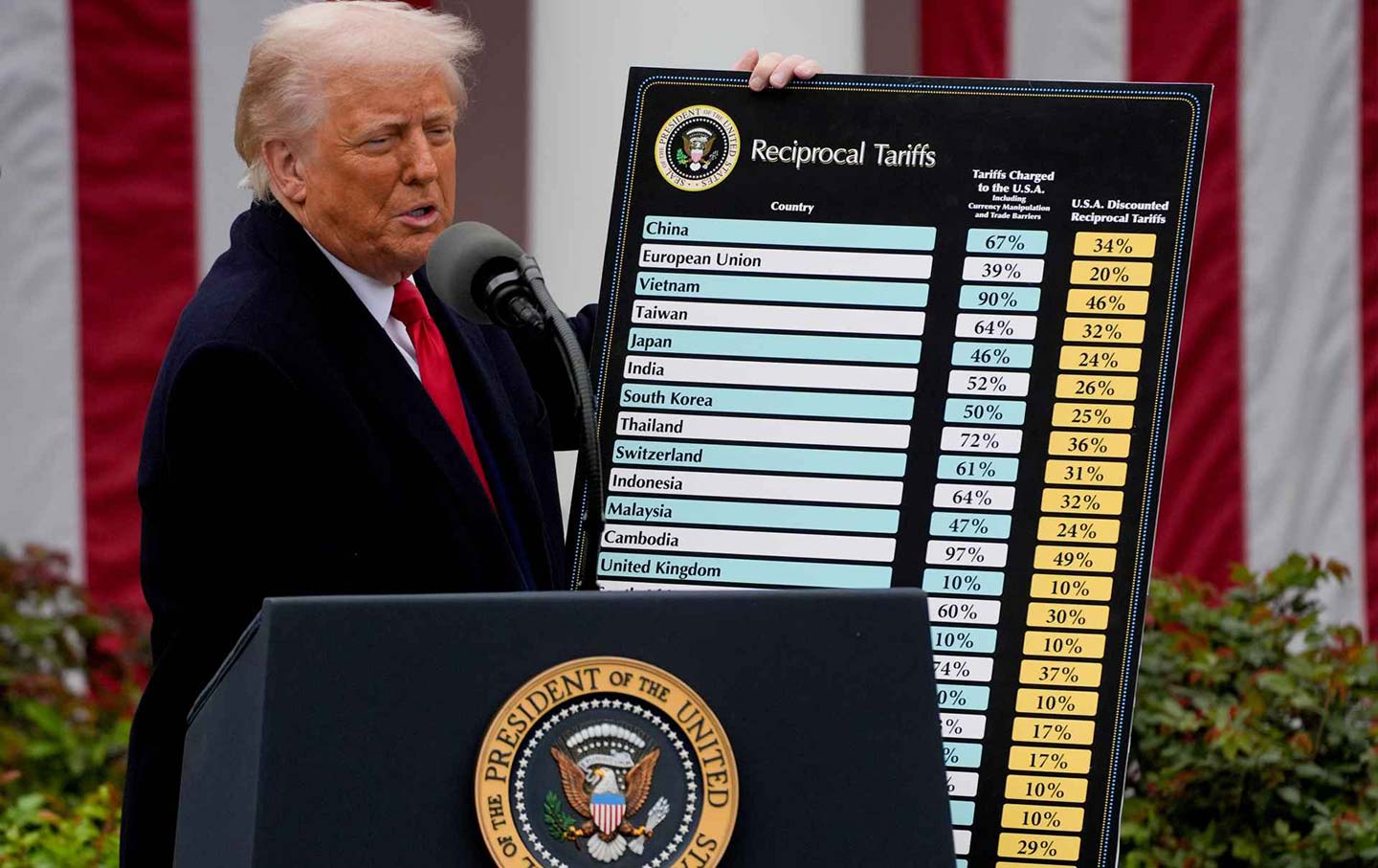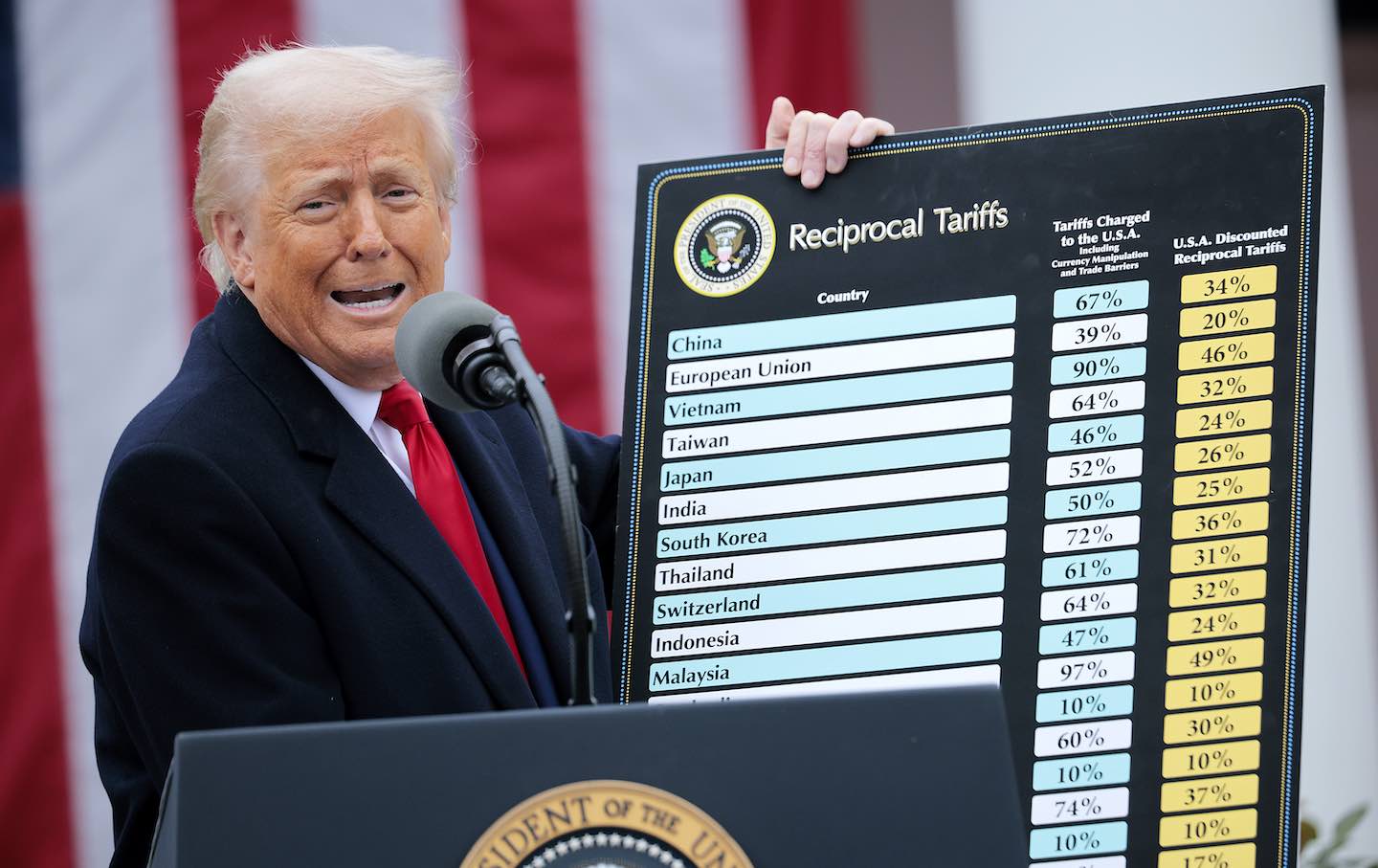They’re Supposed to Be Socially Conscious Investors. Why Are They Funding the War on Gaza?
A range of so-called ESG (environmental, social, and corporate governance) funds have major investments in some of the weapons manufacturers making arms for Israel.
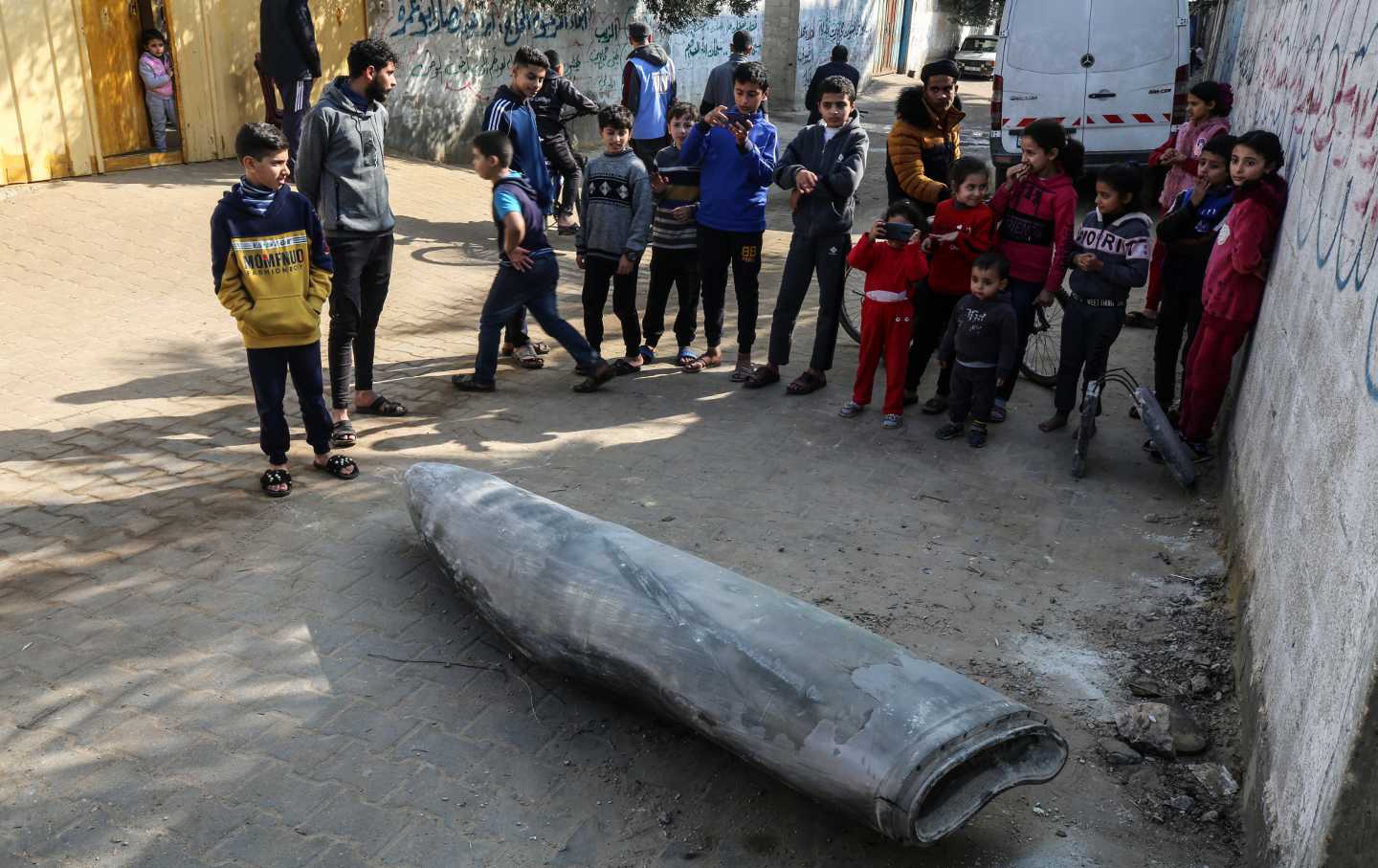
Palestinians are standing next to an unexploded bomb dropped by an Israeli F-16 warplane in Deir al-Balah, central Gaza Strip, on January 1, 2024.
(Majdi Fathi / NurPhoto via Getty ImagesWhen Israel began its bombardment of Gaza following the October 7 Hamas attack, it did so with some of the most advanced weapons systems currently in existence. In addition to the huge quantity of explosives it has dropped on Gaza—70,000 tons in the first three months of the war—Israel is also using high-tech drones, augmented reality, and digitized operations systems in its ground invasion attacks. As in any other war, demand for—and profits from—the production of these systems has boomed.
War is always profitable for companies that make weapons and weapons systems. When Russia invaded Ukraine and the United States sent billions of dollars’ worth of weapons to Kyiv, the American arms industry raked in profits. After the October 7 attack by Hamas on Israel, which killed over 1,100 people, the market value of the biggest US-based arms companies—Lockheed Martin, Raytheon, Boeing, Northrop Grumman, and General Dynamics—increased almost immediately by around $23 billion, and some individual stocks have risen since by as much as 27 percent. (Israel’s subsequent bombing of Gaza has killed over 28,000 people, including more than 12,000 children.) But it isn’t just your usual suspects that are profiting.
A surprising number of climate- and sustainability-related exchange-traded funds (ETFs) and mutual funds have collectively invested billions in defense and weapons manufacturing companies, including the ones helping to fuel Israel’s war in Gaza.
Mutual funds and ETFs bundle various stocks together so people can invest in a collection of companies, often ones that share the same core focus or qualities. In recent years, funds that incorporate climate or environmental, social, and corporate governance (ESG) considerations into their investment approach have risen exponentially as investors seek to align their money with their values.
Yet several climate and ESG funds appear to think that weapons manufacturing doesn’t conflict with those values. For example, American Century Sustainable Equity Fund has over $20 million invested in Lockheed Martin. Lockheed, the world’s largest military contractor, provides the Israeli Air Force with F-16 and F-35 warplanes, an essential component of Israel’s ongoing bombardment of Gaza. (This week, a court in the Netherlands ordered the Dutch government to stop exporting parts for F-35 fighter jets to Israel, citing the risk of their being used in serious violations of international humanitarian law.)
SIT ESG Growth Fund has almost $300 thousand—or almost 3.5 percent of its portfolio—invested in both Lockheed and BAE Systems, the seventh-largest military defense contractor, which supplies the Israeli military with weapons components and technology for combat aircraft, munitions, missile launching kits, and armored vehicles.
The Weapon Free Funds platform, a database that tracks the military weapon and civilian firearm investments of thousands of mutual and exchange-traded funds, gave at least 75 funds with a climate and/or sustainability mandate an F grade because over 4 percent of their portfolios consists of military contractors and weapons manufacturers, including makers of controversial weapons like cluster bombs and white phosphorous. It’s part of a growing trend of ESG funds making incursions into weapons and defense stocks, but also highlights another underlying trend: the increasingly close relationship between climate and military technology.
For experts like Andrew Montes, director of digital strategies at As You Sow, a nonprofit foundation that promotes corporate social responsibility through shareholder advocacy and maintains the Weapon Free Funds database, the cozy ties between ESG or climate funds and military and defense stocks are a worrisome sign. “A long-standing pillar of sustainable investing has generally been to avoid investing in things that are causing death and destruction,” he said. “Sustainable funds should avoid investments in weapons manufacturing—it is a common sense understanding of sustainability.”
Within the ESG world, funds investing in companies looking to provide solutions to climate change or adapt their operations to a low-carbon economy have surged more than 300 percent over the past year and a half.
Including defense and weapons stocks in climate funds creates an uneasy balance. Globally, around 5.5 percent of all carbon emissions are from militaries, and by some estimates, the US Department of Defense is the single largest institutional fossil fuel user in the world. That doesn’t include the energy used in war, the destruction of infrastructure and oil wells, as well as the enormous emissions that go into reconstruction after structures have been destroyed by bombs. A recent study found that the greenhouse gasses emitted in just the first two months of Israel’s attacks against Gaza were greater than the annual carbon footprint of more than 20 of the world’s most climate-vulnerable nations.
Unfortunately, this is a point seemingly lost on ESG investors. Weapons stocks are being increasingly included in ESG portfolios worldwide. According to Morningstar data, as of the end of September last year, over 1200 funds labeled as ESG held defense stocks, up 25 percent from March 2022, when Russia invaded Ukraine.
At the same time, there has been a growing push from defense and weapons-manufacturing companies to be included in ESG ratings, said Amar Causevic, a sustainable finance expert and former policy fellow at the Stockholm Environment Institute. This was especially notable after Russia invaded Ukraine, prompting him to copublish a commentary on why defensive weapons should never be classified as an ESG investment. Scant literature exists on the defense-climate nexus in finance, or the growing inclusion of defense stocks in ESG funds. “Scientifically, it is a completely under-researched topic,” he said.
Including the arms industry in ESG funds brings several problems. Aside from the environmental and social impact, the arms industry is characterized by practices of non-transparency and corruption. A 2020 analysis of 134 of the world’s leading arms companies showed that 100 of them demonstrated little to no commitment to tackling corruption. Regulation is also lacking. “It’s shady. It’s corrupted. It’s a very secretive industry,” said Causevic. Famously, the global trade in bananas is more tightly regulated than the global trade in arms.
A few funds specifically exclude arms, but whether or not companies involved in weapons manufacturing or defense are included in an ESG fund largely comes down to the decisions of fund managers. “They build their investment strategy consciously or unconsciously around overlooking weapons manufacturers,” said Causevic. Not enough research exists to know whether this is financial greed versus unconscious purchases, he said. And until the ESG market becomes better regulated, it will be hard to avoid it.
“In the end, a gun is a gun and a bullet is a bullet and a bomb is a bomb,” he said. “Weapons should never be classified as ESG, but unfortunately they are. And will stay there as long as the systemic issues in our finance systems remain.”
Popular
“swipe left below to view more authors”Swipe →For those who research the global arms trade, the inclusion of such funds is not necessarily surprising. “Most major funds will invest in defense or arms companies unless they are specifically ethical funds that eschew arms investments,” said Samuel Perlo-Freeman, the Research Coordinator at the UK-based Campaign Against Arms Trade, an organization that has been involved in supporting ethical investment campaigns and divestment from arms stocks, especially by public bodies like city councils, churches, and universities.
What makes weaning out arms manufacturers hard is that many of the industry’s biggest players are highly diversified conglomerates with only a small amount of their business dedicated to things like defense systems and weapons production. “Exactly what the boundary is never completely clear,“ Perlo-Freeman said. “General Electric for example has a tiny proportion of their company as arm sales—6 percent—but [that] amounted to over 4 billion dollars in sales, so of course they are a major player.”
For Perlo-Freeman, the biggest considerations are what types of weapons are being produced, where they are being sold, if they are causing civilian harm, and whom they are selling to. “Even if a company is doing good things, if some of the things are particularly egregious, [it’s] a company to be avoided,” he said.
Of course, finding out whether a specific arms company is actively supplying weapons to places like Gaza is not always an easy feat. There is “unprecedented secrecy” in the worldwide supply chain for weapons, said Noam Perry, strategic research coordinator of the Action Center for Corporate Accountability of the American Friends Service Committee (AFSC), who maintains a database tracking the main military contractors involved in the Gaza war and the illegal occupation of the West Bank. “It really depends on the type of weapon.”
The AFSC uses a mixture of military contracts, photos and posts from soldiers and the Israeli military, aerial images, and ground truthing reports from organizations like Human Rights Watch and Amnesty International who search for fragments of missiles to corroborate the information used on their website. There is an inherent bias toward the companies producing physical weapons versus those producing weapons systems or the technology needed to power these wars, Perry said. But even with the incomplete data, tracking—and stopping—the flow of weapons is crucial.
“It is really a massive amount of weapons that are being sent to Israel,” Perry said. “And if Israel didn’t have those, attacks would diminish and less people would be killed.”
There has also been a growth of climate funds that, though they focus on companies driving and profiting from the renewable energy transition and the development of climate adaptation technologies, don’t label themselves as ESGs. This has coincided with an increasing overlap between climate and military technologies could blur the lines between climate and military companies. “There is a growing trend that weapons companies become high-tech companies and high-tech companies become weapons companies,” said Perry. “More and more high-tech companies are dabbling in military applications of civilian products.”
For example, Ball Corp, whose canning jars are ubiquitous in households around the country, also produces satellites used both for military operations and for measuring greenhouse gasses. Their aerospace division was acquired last year by BAE Systems, the world’s seventh-largest military contractor, whose weapon systems are routinely used to bomb Palestinians.
Several climate-related funds received a C rating from the Weapon Free Funds database because of their investments in companies like Hanwha Solutions The South Korean conglomerate is a manufacturer of photovoltaic cells and a big player in the solar energy industry. But its parent company, Hanwha Group, also controls Hanwha Aerospace, South Korea’s largest arms manufacturer, which appears on several exclusion lists for their production of anti-personnel mines and cluster ammunition.
In 2016, Hanwha announced its intention to become “one of the world’s top ten defense companies” and is reportedly eager to use the war in Gaza to enter the US arms market, which supplies weapons to Israel. (South Korean defense stocks also rose after the October 7 attacks.) But the overlap doesn’t end there; last year Hanwha Solutions Corp and Hanwha Aerospace invested $1 billion in their US subsidiary as a way to jointly expand their solar and defense businesses in the United States.
There is also a weapons connection to industry working in food and chemicals. The ETFs VegTech Plant-based Innovation & Climate—a member of the Forum for Sustainable and Responsible Investment—and GMO Climate Change Fund have investments in ICL Group Ltd, an Israeli chemical manufacturer. The company creates specialty fertilizers but is also on several exclusion lists for producing white phosphorus. According to the Palestine Solidarity Campaign, ICL is the sole provider of white phosphorus for the United States Army. White phosphorus is a highly controversial weapon; the chemical can stick to people’s hair and skin, creating burns that can penetrate the bone, causing vision impairment and organ damage. Israel has been found by human rights groups and journalists to have used US-supplied white phosphorous in Gaza and Southern Lebanon in recent months.
In other cases, companies involved in the supply chain of weapons manufacturers also supply crucial parts to renewable energy companies. Take the company Eaton. Funds like Neuberger Berman Crbn Transformation & Infrastructure ETF and Carbon Collective Climate Solutions US Equity ETF have over $1 million—around 5 percent of their portfolios—invested in Eaton, one of the biggest single assets of both funds. Known more commonly as an electrical products, systems, and services company, Eaton bought the defense company Cobham Mission Systems for $2.8 billion in 2021. With that purchase, Eaton has now become one of the 100 largest military defense suppliers and contractors in the world. Cobham previously supplied the refueling probe for the F-35 aircraft, which the Israeli military is using in the air assault on Gaza, and Eaton is listed among 79 companies currently registered on a UK government open license for exports in support of the F-35 program. At the end of last year, pro-Palestinian activists targeted an Eaton factory in London.
Co-CIO James Regulinski of Carbon Collective Investing, who helps manage the Carbon Collective Climate Solutions US Equity ETF, says that the fund considers these kinds of investments seriously, and draws the line at companies that directly produce weapons or weapons systems. “If you were making a missile and the missile’s one use is to blow up and kill people—producing a bunch of CO2 to destroy human well-being—that’s a pretty easy line,” he said.
It’s a seemingly more nuanced line when it comes to companies that are producing supply chain parts that could be used for a variety of different applications, not exclusively military ones. Regulinski said his fund regularly reviews its investments, and if it were to discover a company had started selling weapons or otherwise violating the fund’s investment principles, the fund would pull its money. (The Nation reached out to the other funds listed in this article. They either declined to speak on the record or failed to respond.)
Some funds have started to explicitly mention their disproportionate exposure to arms and other military weapons production. Rockefeller Climate Solutions Fund, which received an F grade from the Weapon Free Fund, has 4 percent of its holdings invested in companies supplying the global arms trade, including Teledyne Technologies, which supplies drones and other military technologies to Israel and Ukraine. If you read the fine print in the fund’s prospectus, the managers write that the ETF “is expected to typically have more meaningful exposure to companies operating in the Industrials sectors,” noting that the industrials sector includes companies engaged in manufacturing and distributing capital goods, “such as those used in defense.”
Regardless of whether or not there is a substantial relationship between arms manufacturing companies and those addressing climate change, “there ought not be” any such connection, said Montes. “Most people if they are investing in climate-focused funds are doing so not just to reduce risk, but also trying to align with their values.” Promoting destruction of people and the environment, he noted, is rarely one of those.

